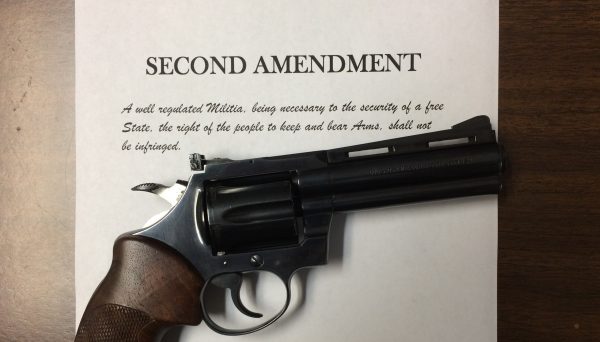By Dave Workman
Senior Editor
In a stunning victory for concealed carry advocates and the Second Amendment Foundation, the U.S. Court of Appeals for the District of Columbia issued a permanent injunction against enforcement of such a requirement in Washington, D.C., but the ruling could have a ripple effect.
The ruling is another court victory for SAF, which won a landmark Supreme Court ruling in 2010 that essentially nullified the Chicago handgun ban and incorporated the Second Amendment to the states via the 14th Amendment.
In a case called Wrenn v. District of Columbia, the 2-1 ruling was authored by Judge Thomas Beall Griffith, a 2005 George W. Bush appointee. He was joined by Senior Judge Stephen F. Williams, a 1986 Ronald Reagan appointee who assumed senior status in 2001. Judge Karen LeCraft Henderson, a 1990 George H.W. Bush appointee, dissented.
Writing for the majority, Judge Griffith noted that, “At the Second Amendment’s core lies the right of responsible citizens to carry firearms for personal self-defense beyond the home, subject to longstanding restrictions…The District’s good-reason law is necessarily a total ban on exercises of that constitutional right for most D.C. residents. That’s enough to sink this law under (the 2008 U.S. Supreme Court’s Heller ruling).”
SAF founder and Executive Vice President Alan M. Gottlieb cheered the ruling, noting that it is just one more step in the foundation’s long-stated goal of “winning firearms freedom one lawsuit at a time.”
“The ruling contains some powerful language that affirms what we have argued for many years, that requiring a so-called ‘good cause’ to exercise a constitutionally-protect right does not pass the legal smell test,” Gottlieb said in a statement. “We’re particularly pleased that the opinion makes it clear that the Second Amendment’s core generally covers carrying in public for self-defense.”
The court majority also said that the District’s “good cause” requirement was essentially designed to prevent the exercise of the right to bear arms by most District residents. Thus, it amounts to a complete prohibition, which would not stand up under the Heller ruling.
The District’s good-reason law is necessarily a total ban on exercises of that constitutional right for most D.C. residents.-Judge Thomas B. Griffith
“The good-reason law,” Judge Griffith wrote, “is necessarily a total ban on most D.C. residents’ right to carry a gun in the face of ordinary self-defense needs…”
The ruling covers a lot of ground and tends to chide other courts for not digging deeply when handing down decisions that uphold the kinds of regulations that the DC Appeals Court set aside.
“Recall that under Heller I,” the court noted, “the Second Amendment protects an individual right of responsible, law-abiding citizens to defend themselves. In particular, then, the right to carry is a right held by responsible, law-abiding citizens for self-defense. But self-defense against what? The most natural answer is that the Amendment enables self-defense at least against the level of threat generally faced by those covered by the Amendment: responsible and law-abiding citizens. Likewise, ‘responsible’ must include those who are no more dangerous with a gun than law-abiding citizens generally are…At a minimum, then, the Second Amendment must enable armed self-defense by commonly situated citizens: those who possess common levels of need and pose only common levels of risk.”
“To read the majority opinion and not come away convinced that such ‘good reason’ or ‘good cause’ requirements are just clever ways to prevent honest citizens from exercising their rights is not possible,” Gottlieb stated.
Perhaps the most powerful statement came at the end of the ruling when Judge Griffith concluded, “To watch the news for even a week in any major city is to give up any illusions about ‘the problem of handgun violence in this country.’ (Heller I, 554 U.S. at 570.) The District has understandably sought to fight this scourge with every legal tool at its disposal. For that long struggle against gun violence, you might see in today’s decision a defeat; you might see the opposite. To say whether it is one or the other is beyond our ken here. We are bound to leave the District as much space to regulate as the Constitution allows—but no more. Just so, our opinion does little more than trace the boundaries laid in 1791 and flagged in Heller I. And the resulting decision rests on a rule so narrow that good-reason laws seem almost uniquely designed to defy it: that the law-abiding citizen’s right to bear common arms must enable the typical citizen to carry a gun. We vacate both orders below and remand with instructions to enter permanent injunctions against enforcement of the District’s good-reason law.”
According to an online biography, back in 2007, a year before the landmark Supreme Court ruling in Heller, Judge Griffith joined Judge Laurence Silberman in the majority ruling in a case known as Parker v. District of Columbia that held the Second Amendment is protective of an individual right to keep and bear arms that is not connected to militia or military service.
This may not be the last word in this case, however. There is the possibility of an appeal or a request for an en banc (full court) hearing.
If this case winds up before the Supreme Court, it would provide the high court with the opportunity to further define the parameters of the right to keep and bear arms.




